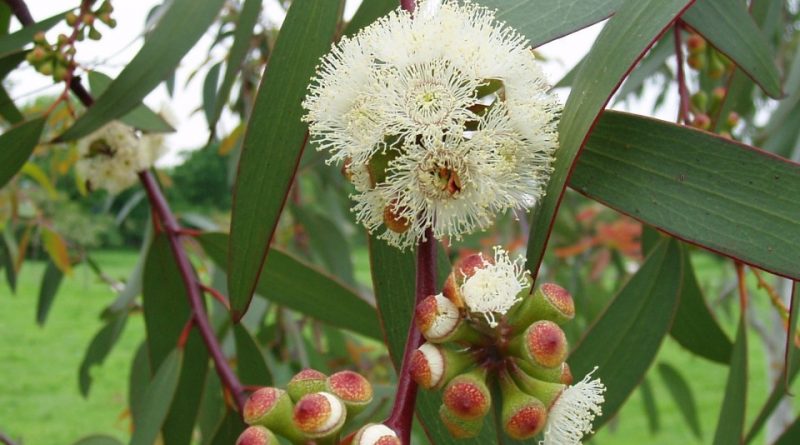Eucalyptus camaldulensis
Eucalyptus camaldulensis
The red eucalyptus, or eucalyptus of Camaldoli or rostratus (Eucalyptus camaldulensis, Dehnh. 1832) is an arboreal species belonging to the Myrtaceae family.
Systematics –
From the systematic point of view it belongs to the Eukaryota Domain, Kingdom Plantae, Magnoliophyta Division, Magnoliopsida Class, Myrtales Order, Myrtaceae Family and therefore to the Eucalyptus Genus and to the E. camaldulensis Species.
The term Eucalyptus rostrata is synonymous.
Etymology –
The term Eucalyptus comes from the Greek ἐῧ éu true, well, to perfection and κᾰλυπτός kalýptos cover, hide: for the lobes of the chalice and the joined petals that form a cap that completely encloses the closed buds. The specific epithet of Camaldulensis derives from Camaldulum, the Latinization of Camaldoli, hill near Naples, where stands a hermitage of the Benedictine Camaldolese order; the species was described for the first time by the German botanist Friedrich Dehnardt (1787-1870), curator of the botanical garden of Naples and author of the Catalogus plantarum horti camaldulensis.
Geographic Distribution and Habitat –
The eucalyptus rostratus is a plant native to temperate Australia. In Italy it was introduced in 1803 and today it is widespread in the Mediterranean regions and in many temperate areas of the globe. Its habitat is that of loose and deep soils, especially sandy in dry areas where the plant shows a high resistance.
Description –
The Eucalyptus camaldulensis is a tree that can reach 40-50 meters in height and has a vertically extensively expanded foliage. The trunk is slender and erect, with smooth bark, greenish white, which flakes into darker caduce plates of various shapes. It has sickle-shaped, evergreen, sparsely aromatic lanceolate leaves, up to 22 cm long and 1-1.5 cm broad.
The flowers are yellowish, fragrant, pedunculated, gathered in small pedunculate umbrellas formed by 5-10 elements. The antesis is in the period between spring and summer. The fruit is a hemispheric pisside of 7-8 mm, which opens at maturity for 4 valves; the seeds, which are numerous, have a brown color.
Cultivation –
The cultivation of Eucalyptus camaldulensis lends itself to fast repopulations with trees in even dry areas. The tree develops rapidly from both fresh and dried or kept fresh seeds. The plant quickly becomes strong and can withstand drought already in the pipes used in the reforestation. With this species you can also produce excellent bonsai and the plant can easily grow both from the base and from the epicormical gems. According to official statistics, with its 5000 Km2 is one of the most cultivated eucalyptus in the world.
Uses and Traditions –
On the Australian continent the red eucalyptus is a very widespread species along many waterways of the inland areas. The tree produces a very useful shade in the hot heat of the areas of central Australia and plays an important role in stabilizing river banks, consolidating the soil and limiting erosion.
In Italy, rostral eucalyptus, especially in the past, has been heavily employed in the South and in the islands. Being a fast-growing and frugal species, it has been used in the reforestation of sandy dunes, in the creation of windbreaks, in road trees and in wood arboriculture.
In the past few years it was thought that, thanks to the terpenes contained in its leaves, it kept away the anopheles mosquito, vector of malaria. In fact, the phenomenon is instead linked to the drying up of the land carried out by reforestation with eucalyptus.
From this species of red eucalyptus is obtained a wood, of bright reddish color, which can vary in shade, depending on age and environmental conditions. It is a very friable and often knotty wood and therefore difficult to work with. The wood was originally used to make boxes, posts for fences and rafters; in recent times, due to its red color, it is also used as furniture lumber. However, it is a questionable choice because you have to be careful about the chosen wood as it is very sensitive to changes in air humidity. Wood is also appreciated by cabinet makers, particularly if dry and well seasoned.
The wood of the plant also produces an excellent coal used in Brazil for the production of iron and steel objects.
From an ecological point of view, even if Eucalyptus camaldulensis, like other eucalyptus trees, is not very suitable for reforestation because of the difficulty of reconstructing a undergrowth, it is still a honeyed species that can be used in apiculture to produce honey. eucalyptus; something that is done in particular in Brazil and in Australia. The calories of eucalyptus honey are not very different from those of other types of honey. From the leaves it is possible to extract eucalyptol, an ethereal oil of medicinal use.
Preparation Mode –
From a food point of view this red eucalyptus lends itself well to the production of eucalyptus honey. It is a honey rich in antioxidants and flavonoids that play an important role in the welfare state of an organism. These substances in fact reduce free radicals, which slow down cellular aging. Another important advantage of eucalyptus honey is that of intervening on inflammatory phenomena and many studies rank it among the best types of antioxidant and anti-aging honey.
Guido Bissanti
Sources
– Acta Plantarum – Flora of the Italian Regions.
– Wikipedia, the free encyclopedia.
– Treben M., 2000. Health from the Pharmacy of the Lord, Advice and experience with medicinal herbs, Ennsthaler Publisher
– Pignatti S., 1982. Flora of Italy, Edagricole, Bologna.
– Conti F., Abbate G., Alessandrini A., Blasi C. (edited by), 2005. An annotated checklist of the Italian vascular flora, Palombi Editore.
Attention: Pharmaceutical applications and alimurgical uses are indicated for informational purposes only, they do not in any way represent a medical prescription; there is therefore no liability for their use for curative, aesthetic or food purposes.


